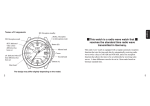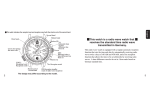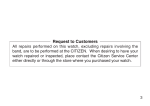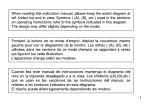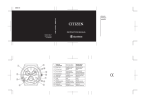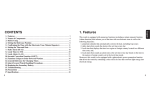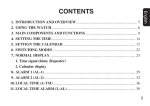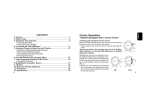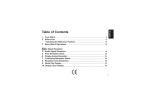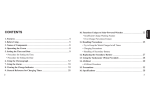Download Citizen A414 Instruction manual
Transcript
Please fully charge your watch before use by exposing it to light. Reception result Reception level / Reception result Hour hand Minute hand Crown Button (B) Button (A) Second hand When the watch does not operate according to the instruction manual, this means that it is insufficiently charged. When this happens, charge the watch before using by exposing to direct sunlight for at least 2 hours. [This watch is equipped with a power save function (Power Save 1 and 2) that reduces power consumption] Power Save 1: When the solar cell is not being exposed to light for more than 24 hours continuously, the second hand and the minute hand stop and the power save state is entered. Power Save 2: The Power Save 1 state will continue for about 2 days after which the Power Save 2 state is entered. * Upon entering the power save state, the second hand stops at the 12 o’clock position while the minute hand stops at the reference position. For details concerning the power save function, please read [6. A. Power Save Function]. Time difference display The design may differ slightly depending on the model. 2 3 English Reception in progress This watch is a radio wave watch that automatically corrects the time and date by receiving the standard time radio wave (time information) transmitted in Germany. In addition, this watch also functions as an analog solar-powered watch equipped with a photoelectric power generation function that drives the watch by converting light energy into electrical energy. It is also equipped with other useful functions, including a power save function that reduces power consumption of the watch when the solar cell is not exposed to light. * Locations Where Radio Wave Reception may be Difficult • It may be difficult to receive radio waves in certain locations. The time and date are not set correctly if radio waves are unable to be received. • There rarely may be times when the time and date are not set correctly even if radio waves are received. When this happens, carefully read the section on page 8 entitled, “Radio Wave Receiving Function” and then try repeating the procedure for receiving radio waves (either manually or automatically). 4 Contents 1. Before Using ..................................................................................................... 8 A. Radio Wave Receiving Function <For Good Reception> <Locations where Reception may be Difficult> <General Reference for Receiving Areas> B. Photoelectric Power Generation Function 2. Receiving Radio Waves ................................................................................. 15 3. Setting the Time and Date by Radio Wave Reception ............................... 17 A. Radio Wave Reception (Regular Automatic Reception and Free Reception) B. Indication of Reception Level during Radio Wave Reception C. Indication of Radio Wave Reception Result <Confirmation of Reception Result> D. Return Automatic Reception E. Recovery Automatic Reception 5 4. Time Difference Correction Function ......................................................... 24 A. Setting Procedure for Time Difference Correction (1) B. Setting Procedure for Time Difference Correction (2) 5. Manually Setting the Time and Date ........................................................... 33 A. Changing the Display B. Correcting the Seconds and Minutes C. Correcting the Elapsed Years and Month <Setting to a Non-Existent Date> <Reading the Month and Year> <Quick Reference Chart for Number of Years Since Leap Year> D. Correcting the Hours and Date 6. Unique Functions of Solar-Powered Watches ............................................ 42 A. Power Save Function <Power Save 1> <Canceling Power Save 1> <Power Save 2> <Canceling Power Save 2> 6 7. 8. 9. 10. 11. 12. 13. 14. B. Insufficient Charge Warning Function C. Time Setting Warning Function D. Overcharging Prevention Function General Reference for Charging Times of Solar-Powered Watches ........ 50 Solar-Powered Watch Handling Precautions ............................................. 52 <Try to Keep the Watch Charged at all Times> Replacing the Secondary Battery ................................................................. 53 Setting the Reference Position ...................................................................... 54 A. Checking the Reference Position B. Setting the Reference Position All-Reset ......................................................................................................... 59 Troubleshooting ............................................................................................. 61 Precautions ..................................................................................................... 62 Specifications ................................................................................................. 68 7 1. Before Using Antenna A. Radio Wave Receiving Function <For Good Reception> · This watch incorporates an antenna for receiving radio waves at the 12:00 position inside the case. For good reception, it is ideal to have the 12:00 position of the watch facing in the direction of the radio wave transmitter station. · Try receiving radio waves using the reception level function while changing the orientation of the watch or location. Finding the location and direction at which radio waves can be received easily results in more reliable reception. · To obtain stable reception, do not move the watch during reception. · Radio waves may be hard to receive due to blockage by a metallic object or the environment. When inside a building and so on, reception should be performed as close to a window as possible. 8 Radio waves may be unable to be received in close proximity to the radio wave transmitter station (within a distance of about 10 km). In addition, radio waves may not be received properly even if they are able to be received. If this happens, either change the orientation of the watch antenna to 45 degrees to 90 degrees relative to the radio wave transmitter station or move to a location farther away from the radio wave transmitter station (more than about 10 km away), and then try receiving radio waves again. 9 <Locations where Reception may be Difficult> It may not be possible to properly receive radio waves at the following locations susceptible to generation of radio wave noise or under the following environment conditions that cause difficulty in receiving radio waves. (1) Locations subject to extremely high or low temperatures (2) Inside a reinforced concrete building, between tall buildings or in valleys between mountains or underground (3) In a car, train or airplane (4) Near high-tension wires (power lines), railroad overhead wires or airports (communication facilities) (5) Near a cellular telephone in use (6) Near household electric appliances or OA equipment such as TV sets, refrigerators, personal computers, fax machines, etc. * Radio waves cannot be received properly while walking or traveling in a motor vehicle, etc. 10 <General Reference for Receiving Areas> A general reference for the areas where the watch can receive standard time radio waves is as follows. However, these areas may vary depending on the time zone, seasonal variations and weather (presence of lightning, etc.). Since this map only provides a general reference of the standard receiving areas, it may not apply in some particular locations even within the range shown on the map. 11 Standard time radio wave transmitter station Location of transmitter station General reference for areas where radio waves can be received DCF77 Mainflingen, Germany (25 km southeast of Frankfurt) Radius of about 900 km from radio wave transmitter station (radio waves may not be able to be received in the vicinity of Lake Leman) Oslo Hamburg Warsaw Berlin Paris Budapest Marseilles Rome Beograd Barcelona Naples 12 B. Photoelectric Power Generation Function This watch uses a secondary battery to store electrical energy. Once fully charged, the watch will continue to keep the correct time for about 8 years (in the Power Save 2 state) without further charging. Furthermore, it will continue to keep the correct time for about 9 months when the Power Save modes are not activated. Power Save: When power generation stops as a result of the solar cell not being expose to light, the power save function is activated to reduce the power consumption of the watch. (For more details, please refer to section 6-A entitled, “Power Save Function”.) <For Optimum Use of this Watch> In order to use this watch comfortably, try to keep the watch charged at all times. There is no risk of overcharging no matter how often the watch is charged (overcharging protection function). Expose the dial (solar cell) to light when charging. 13 <Try to Keep the Watch Charged at all Times> · If you wear long sleeves, the fabric may cover the watch and prevent it from being exposed to light resulting in the watch becoming insufficiently charged. · When the watch is removed, try to place it in as bright a location as possible. This will enable the watch to continue to run properly at all times. 2. Receiving Radio Waves There are two ways to receive radio waves, namely automatic reception (regular automatic reception, return automatic reception and recovery automatic reception) and free reception. When radio waves are received properly, the time (hours, minutes, seconds, daylight savings time) and date (month, day, year) are corrected automatically. 1. Regular Automatic Reception: Radio waves are received automatically twice a day at 3:00 AM and 4:00 AM each day. 2. Free Reception: Radio waves can be received at any time. 3. Return Automatic Reception: Radio waves are received when the watch automatically returns to the reception state after the Power Save 2 state has been canceled. 14 15 4. Recovery Automatic Reception: The watch switches to the recovery automatic reception state and receives radio waves when the watch is sufficiently charged after having stopped due to being insufficiently charged. [Data Received from German Standard Time Radio Wave] · Time information: Hours, minutes, seconds, daylight savings time · Date information: Month, day, year 3. Setting the Time and Date by Radio Wave Reception It is recommended to try receiving radio waves while changing the direction and location of the watch to find the location and direction at which reception is easiest while referring to the reception level. Do not move the watch when receiving radio waves. A. Radio Wave Reception (Regular Automatic Reception and Free Reception) (1) Reception method 16 Regular automatic reception The second hand automatically moves to the RX (reception in progress) position (0 seconds position) twice a day at 3:00 AM and 4:00 AM each day, after which the watch begins to receive radio waves. Free reception When button (A) is pressed after about 2 seconds, the second hand rapidly moves to the RX (reception is progress) position (0 seconds position), after which the watch begins to receive radio waves. Note: If button (A) is continuously depressed for 10 seconds or more, the watch changes to the “Reference Position (0 position/12:00 position) Check”. 17 (2) Hand location during reception (3) Reception results After the second hand has indicated that reception is in progress (RX), it moves to the reception level. The minute hand stops at the location corresponding to the second hand. If reception is successful: The time (including daylight savings time) and date are corrected automatically based on the results of reception. If reception has failed: The watch returns to the time and date display stored in the watch prior to reception. (4) Confirmation of reception result When button (A) is pressed after receiving, the second hand rapidly moves to the reception result (reception level) and stops. · The watch automatically returns to the current time after 10 seconds. In addition, the watch can also be returned to the current time by pressing button (A). However, if button (A) is continuously depressed for 2 seconds or more, the second hand moves to the RX position indicating that reception is in progress and free reception begins. Note: Reception results cannot be confirmed even if button (A) is pressed while each hand is returning to the current time following completion of reception. Confirm reception results by pressing button (A) only after each hand has returned to the current time. 18 B. Indication of Reception Level during Radio Wave Reception During radio wave reception, the second hand waits at the reception position corresponding to the reception status and indicates the reception level (degree of ease of radio wave reception). Reception level Symbol Second hand reception level indication position When radio wave reception level is high H 9 minute position When radio wave reception is moderately high M 6 minute position When radio wave reception is low L 3 minute position 19 C. Indication of Radio Wave Reception Result Reception level can be confirmed following reception of radio waves. <Confirmation of Reception Result> · When button (A) is pressed, the second hand rapidly moves to the position corresponding to the reception result and indicates the reception level for 10 seconds. Note: Free reception begins if button (A) is pressed for 2 seconds or more. · The watch automatically returns to the current time after 10 seconds. In addition, the watch can also be returned to the current time by pressing button (A). However, if button (A) is continuously depressed for 2 seconds or more, the second hand moves to the RX position indicating that reception is in progress and free reception begins. Reception results Second hand reception level indication position When reception was successful · When radio waves were received at a high reception level H 9 minute position · When radio waves were received at a moderate reception level M 6 minute position · When radio waves were received at a low reception level L 3 minute position NO 55 minute position When reception failed 20 Symbol 21 D. Return Automatic Reception E. Recovery Automatic Reception When the Power Save 2 state (during which the second hand and minute hand are stopped) is canceled, the watch automatically changes to the reception state after rapidly returning to the time stored in memory, and begins to receive radio waves. · When reception has been successful: The time and date are corrected automatically and the watch begins to run. · When reception has failed: The watch returns to the time and date display stored in memory prior to reception and begins to run. When the watch is sufficiently recharged after having stopped as a result of being insufficiently charged, the watch automatically performs one cycle of recovery automatic reception. · When reception has been successful: The time and date are corrected automatically and the watch begins to run. The watch can be used normally at this time. · When reception has failed: The time setting warning function (irregular 2-second interval movement) is activated. In this case, either perform free reception or set the time and date manually. 22 23 4. Time Difference Correction Function A. Setting Procedure for Time Difference Correction (1) This watch is equipped with two types of time difference correction functions. The correction state changes as shown below as a result of operating the crown and buttons. <Time Difference Correction Function (1)> · The time difference can be set in 1 hour units relative to the German standard time that has been received by the watch. · The setting range is from –2 hours to +2 hours. <Time Difference Correction Function (2)> · The time difference can be set to an arbitrary time in 1 hour units by correcting the hour hand manually. · The time difference can be set in areas where the German standard time radio wave is unable to be received. In the case of having received the German standard time radio wave (either by free reception or regular automatic reception) after setting the time difference using the time difference correction function (2), the time difference is automatically corrected to the German standard time. 24 Crown pulled out to first or second position [Normal Hand Movement] Button (B) pressed Button (B) Automatically returns after 10 seconds or button (B) pressed Display of the time difference state stored in memory (second hand: between 24 and 36 seconds) Time difference correction mode (demonstration movement by hour hand) Crown clicked to the right or left Time difference correction Crown returned to normal position 25 [Time Difference Display] Button (B) Range over which time difference can be set relative to German standard time 26 (1) When button (B) is pressed during normal hand movement, the second hand changes to the time difference display, and indicates the time difference stored in memory. (2) When the crown is pulled out to the first or second position, the hour hand performs a demonstration movement after which it indicates the current time and stops. (3) The time difference is corrected when the crown is clicked in either direction. · The second hand moves by +1 hour (3 seconds) when the crown is clicked once to the right. After the second hand moves (time difference display state), the hour hand moves by 1 hour. · The second hand moves by –1 hour (3 seconds) when the crown is clicked once to the left. After the second hand moves, the hour hand moves by 1 hour. Notes: · The time difference is not corrected even if the crown is clicked while the hands are moving. In the case of correcting the time difference continuously, only operate the crown after confirming that the hands have stopped moving. · The time difference is not corrected if the setting range (-2 to +2 hours) has been exceeded even if the crown is operated. (4) Return the crown to the normal position after correcting the time difference. 27 [Time Differences of Major Countries Relative to Germany] Countries having the same time difference as Germany Norway Sweden Denmark Netherlands Czech Slovakia Belgium France Spain Switzerland Italy Austria Poland Use of daylight savings time Yes Yes Yes Yes Yes Yes Yes Yes Yes Yes Yes Yes Yes Time difference from Germany of –1 hour Ireland Iceland England Portugal Use of daylight savings time Yes No Yes Yes Time difference from Germany of +1 hour Finland Belarus Ukraine Romania Bulgaria Greece Turkey Lebanon Israel Jordan Use of daylight savings time Yes Yes No Yes Yes Yes Yes Yes Yes Yes Time difference of +2 hours from Germany Iraq Kuwait Saudi Arabia Russia (Moscow) Use of daylight savings time Yes No No Yes Note: Since daylight savings time is contained in the standard time radio wave and corrected automatically, it is not required to be corrected. However, correction is required in the case of using in areas where daylight savings time is not used. 28 29 B. Setting Procedure for Time Difference Correction (2) The time difference can be corrected for 30 seconds after pressing button (A) or for 30 seconds following completion of hand movement after the crown has been pulled out to the first position. The date also changes in coordination with the hour hand. Crown pulled out to first position Crown returned to normal position Date correction (elapsed years/month) (A) Hour hand/day disk correction (Demonstration movement by hour hand) (A) Button (A) Returns automatically after 10 seconds or button (A) pressed 30 (1) Pull the crown out to the first position. · The second hand moves to the position of the “year” and “month” stored in memory and then stops. (2) When button (A) is pressed, the hour hand performs demonstration movement after which the watch changes the “hour” and “date” time difference correction state. · The second hand rapidly returns to the current time and the watch begins to run. (3) Turn the crown to set to the “hour” of the region for which time difference is to be set. ① If turned to the right (by one click), the hour hand moves forward (clockwise) by one hour. ② If turned to the left (by one click), the hour hand moves backward (counterclockwise) by one hour. · Turning the crown continuously (by two clicks or more) causes the hour hand to move continuously. · Continuous movement can be interrupted by clicking the crown by one click to the left or right. 31 Note: When correcting the time difference, pay attention to AM and PM in the region for which time difference is to be set. The time when the date changes is AM. The date changes between the hours of 10:00 PM and 3:00 AM. (4) Return the crown to the normal position after correcting the time difference. 5. Manually Setting the Time and Date This watch also allows the time and date to be set by manual operation when radio waves are unable to be received. A. Changing the Display The correction state is changed in the manner shown below by operating the crown and buttons. [Normal Hand Movement] Crown pulled out to second position Crown pulled out to first position Crown returned to normal Button position (A) Returns automatically after 10 seconds or button (A) is pressed 32 Date correction (elapsed years/month) (A) Time correction (minutes, seconds) Crown pushed in to first position (Demonstration movement by hour hand) Hour hand/day disk correction 33 B. Correcting the Seconds and Minutes (1) When the crown is pulled out to the second position, the second hand rapidly moves to the 0 seconds position and stops. · If the second hand does not stop at the 0 seconds position, check the “Reference Position” and perform the procedure for “Setting the Reference Position”. (2) Turn the crown to set the minutes. ① When the crown is turned to the right (by one click), the second hand makes one revolution while moving in the clockwise direction, and the minute hand advances by one minute. ② When the crown is turned to the left (by one click), the second hand makes one revolution while moving in the counter-clockwise direction, and the minute hand moves back by one minute. · Turning the crown continuously (by two or more clicks) causes the second hand and minute hand to move continuously. · Turn the crown to the left or right by one click to interrupt continuous movement of the hands. 34 Notes: · Since the hour hand moves in coordination with the minute hand, the hour hand can be set by continuous movement of the second hand and minute hand. In addition, the date also changes in coordination with the hour hand. · The watch automatically advances past non-existent dates such as February 30 or April 31. While the watch is advancing, the second hand and minute hand wait at the 12:00 position, while the hour hand moves automatically to pass by the non-existent date. (3) Return the crown to the normal position in synchronization with a telephone or other time service. 35 C. Correcting the Elapsed Years and Month When the crown is pulled out to the first position, the second hand changes to an indication of the number of years that have elapsed since the most recent leap year (elapsed years) and the month. (1) When the crown is pulled out to the first position, the second hand moves to the year and month stored in memory and stops. (2) Turn the crown to set the year and month. ① Turn the crown to the right (by one click) to align the second hand at the position corresponding to the number of years that have elapsed since the most recent leap year and the month. ② When the crown is turned to the left (by one click), the second hand moves backwards. · Turning the crown continuously (by two clicks or more) causes the second hand to move continuously. · Turn the crown to the left or right by one click to interrupt continuous movement of the second hand. 36 Note: When the second hand makes two revolutions continuously, it rapidly returns to the position of the original year and month. Examples: Case of December in a leap year: Align the second hand at the 0 seconds position. Case of April in the third year after the most recent leap year: Align the second hand at the 23 seconds position (between 4:00 and 5:00). (3) After correcting the year and month, return the crown to the normal position. The second hand returns to the current time and the watch begins to run. 37 • Reading the Year Leap year: 1st graduation of each month zone 1st year after leap year: 2nd graduation of each month zone 2nd year after leap year: 3rd graduation of each month zone 3rd year after leap year: 4th graduation of each month zone Decemb er Leap year 1st year 2nd y 3rd y ear ear Le 1s ap ye a 2n t ye d ar r ye ar <Setting to a Non-Existent Date> If the month has been changed after setting the date causing the date to be set to a non-existent date, the date is automatically changed to the first day of the following month when the crown is returned to the normal position from the correction position. Ja nu y r yea ap Le t year 1s year 2nd ar 3rd ye ruar <Reading the Month and Year> • Reading the Month January: Between 1:00 and 2:00 February: Between 2:00 and 3:00 : December: Between 12:00 and 1:00 ar ye Feb d 3r ary <Quick Reference Chart for Number of Years Since Leap Year> Year 2000 2001 2002 2003 Elapsed year Leap year 1st year 2nd year 3rd year Year 2004 2005 2006 2007 Elapsed year Leap year 1st year 2nd year 3rd year 3r L 1 eap 2n st ye year a d ye r ar d Ap ril ar ye 38 39 D. Correcting the Hours and Date Since the date changes in coordination with the hour hand, it cannot be corrected independently. The date is changed by continuously advancing the hour hand. The hour hand and date can be corrected for 30 seconds after pressing button (A) or for 30 seconds after the hour hand has stopped moving. (1) Pull the crown out to the first position. · The second hand moves to the position of the year and month stored in memory and stops. (2) When button (A) is pressed once, the hour hand performs a demonstration movement and then changes to the hour and date correction state. · The second hand rapidly returns to the current time and begins to move (3) Turn the crown continuously to continuously advance the hour hand and set the date. · The date changes between the hours of about 10:00 PM and 3:00 AM. · In the case the month is set to a month with less than 31 days, a non-existent date is automatically passed by and the watch indicates the first day of the following month even if the date is changed from the 30th to the 31st. 40 (4) Turn the crown to set the hours. ① When the crown is turned to the right (by one click), the hour hand advances (in the clockwise direction) by one hour. ② When the crown is turned to the left (by one click), the hour hand moves back (in the counter-clockwise direction) by one hour. · Turning the crown continuously (by two or more clicks) causes the hour hand to move continuously. · Turn the crown to the left or right by one click to interrupt continuous movement of the hour hand. Note: When correcting the time, set the time while paying attention to AM and PM. The time when the date changes is AM. (5) After correcting the time, always make sure to return the crown to the normal position. 41 6. Unique Functions of Solar-Powered Watches When the watch becomes insufficiently charged, a warning function is activated and the display changes as shown below. If insufficiently charged When the time is set with the watch sufficiently charged [Return Automatic Reception State] [Normal Display] [Time Setting Warning Display] [Recovery Automatic Reception] [Insufficient Charge Warning Display] If insufficiently charged state continues for 11 days or more If reception fails Watch stops When reception is successful after returning from Power Save 2 *2 Irregular 2second interval movement When watch becomes sufficiently charged *1 2-second interval movement If reception is successful When watch becomes sufficiently charged *1: If the watch has stopped as a result of being insufficiently charged, a minimum of about 30 seconds are required until recovery automatic reception is performed even if the watch is exposed to light. *2: If automatic reception has failed, the watch returns to the time and date prior to attempting reception. 42 43 A. Power Save Function <Power Save 1> The second hand stops to save power when it reaches the 0 seconds position if the solar cell is not exposed to light and power is not generated for 24 consecutive hours. · The minute hand stops at the position corresponding to the second hand. · The hour hand and date change from normal movement (3-minute interval movement) to 1- hour interval movement. Note: Reception can still be performed either by regular automatic reception or free reception. However, in the case of performing free reception, Power Save 1 is canceled due to the switching operation. <Canceling Power Save 1> Power Save 1 is canceled either by resuming power generation by exposing the solar cell to light, or by operating the crown or buttons. · When Power Save 1 is canceled, the second hand and minute hand rapidly return to the current time and begins 1-second interval movement. (When Power Save 1 is canceled by pressing button (A), the display returns to the current time after displaying the reception results for about 10 seconds.) 44 · The hands move in the clockwise or counter-clockwise direction to rapidly return to the current time. · It takes a maximum of about 1 minute for the hands to return to the current time. <Power Save 2> The watch automatically switches to the Power Save 2 state to further reduce current consumption if the Power Save 1 state continues for approximately 2 days. · Each hand and the date continue in the Power Save 1 state. Note: Regular automatic reception is not performed every day. In addition, free reception can also not be performed. <Canceling Power Save 2> Power Save 2 is canceled when power generation is resumed by exposing the solar cell to light. · Recovery automatic reception is performed after the second hand and minute hand rapidly move to the current time. 1-second interval movement starts following completion of reception and the watch returns to normal operation. · Power Save 2 cannot be canceled with the crown or buttons. 45 Notes: · The watch also switches to the power save function from either 2-second interval movement (insufficient charge warning function) or irregular 2-second interval movement (time setting warning function). · During the time the secondary battery is fully charged and the overcharging prevention function is activated, the power save function is not activated even if power is not generated as a result of the solar cell not being exposed to light. In addition, the power save function is similarly not activated when the secondary battery temporarily becomes fully charged as a result of the solar cell being exposed to intense light. · Depending on the environment in which the watch is stored and so forth, reception may not be completed successfully even if recovery automatic reception is performed after cancellation of Power Save 2. It is therefore recommended to perform free reception before using the watch. 46 B. Insufficient Charge Warning Function When the capacity of the secondary battery becomes low as a result of not exposing the solar cell to light, the second hand changes to 2-second interval movement (insufficient charge warning function) to indicate that the watch is insufficiently charged. Although the watch continues to run normally at this time, after about 11 days have passed since the start of 2-second interval movement, the watch ends up stopping as a result of being insufficiently charged. Sufficiently recharge the watch by exposing to light so that the second hand returns to its original 1-second interval movement. Notes: · The time and date cannot be corrected manually during 2-second interval movement. · Regular automatic and free reception are also not available. Although the receiving station can be switched, the receiving station is not indicated. · The all-reset procedure can be performed. 47 C. Time Setting Warning Function D. Overcharging Prevention Function Recovery automatic reception is performed when the watch is exposed to light and sufficiently recharged after having stopped as a result of being insufficiently charged. · If reception has been successful, the time is corrected and the second hand begins 1-second interval movement. · If reception has failed, the second hand moves by irregular 2-second interval movement (time setting warning function) indicating that the time is incorrect. Reset the time and date either by free reception or by manual setting. · Irregular 2-second interval movement will continue unless the time is reset. Note: In the case the watch has stopped as a result of being insufficiently charged, a minimum of about 30 minutes are required until recovery automatic reception is performed even if the watch is sufficiently exposed to light. When the secondary battery becomes fully charged, the overcharging prevention function is activated to prevent the battery from being charged further. 48 49 7. General Reference for Charging Times of Solar-Powered Watches The time required for recharging varies according to the model of the watch (color of the dial, etc.). The following times are shown below only to serve as a reference. · Recharging time refers to the amount of time the watch is continuously exposed to light. Charging time Illuminance (lx) 500 1,000 3,000 10,000 100,000 50 Charging time for 1 day of operation Charging time from the stopped state to recovery automatic reception Charging time to fully charge 4 hours 120 hours ······ 2 hours 60 hours ······ 40 minutes 20 hours 200 hours Outdoors, cloudy 12 minutes 6 hours 60 hours Outdoors, summer, under direct sunlight 3 minutes 1 hour 45 minutes 15 hours Environment Interior lighting 60-70 cm (24-28 in) under a fluorescent lamp (30 W) 20 cm (8 in) under a fluorescent lamp (30 W) Charging time to fully charge: Time required for recharging the watch from the stopped state when insufficiently charged to fully charged. Charging time for 1 day of operation: Time required for recharging the watch to run for 1 day. Note: Once fully charged, this watch will continue to run without recharging for approximately 8 years (when in the Power Save 2 state). Furthermore, it will continue to keep the correct time for about 9 months when the Power Save modes are not activated. However, once it stops running due to being insufficiently charged, a considerable amount of time is required to recharge so that it starts running again as indicated in the table. Try to recharge the watch daily whenever possible. 51 8. Solar-Powered Watch Handling Precautions 9. Replacing the Secondary Battery <Try to Keep the Watch Charged at all Times> · If you wear long sleeves, the fabric may cover the watch and prevent it from being exposed to light resulting in the watch becoming insufficiently charged. · When the watch is removed, try to place it in as bright a location as possible. This will enable the watch to continue to run properly at all times. Unlike ordinary batteries, the secondary battery used in this watch does not have to be periodically replaced since it is able to be charged and discharged repeatedly. CAUTION: Charging Precautions · Avoid charging at high temperatures (over 60°C /140°F) since allowing the watch to reach a high temperature during charging can cause a malfunction. Examples: Charging by placing the watch too close to a light source that may become hot such as an incandescent lamp or halogen lamp, or charging by placing the watch on an automobile dashboard that can easily reach a high temperature. · When charging the watch with an incandescent lamp, always make sure to place the watch at least 50 cm (20 in) away from the light source to prevent the watch from reaching a high temperature. 52 53 10. Setting the Reference Position In the case the reference position of the watch has changed due to being subjected to a strong shock or the effect of static electricity, check the reference position (0 position/12:00 position) that serves as the basis of operation. If the second hand does not indicate the correct position, it is possible that the reference position may have shifted. Check the reference position of each hand using the procedure described below. (2) When button (A) is pressed for about 2 seconds, the hands rapidly return to the current time. Alternatively, the watch will automatically return to the current time if the buttons or crown are not operated for 2 minutes or more. Note: Set the reference position if any of the hands or date do not indicate the reference position. A. Checking the Reference Position (1) Continuously depress button (A) for at least 10 seconds with the crown in the normal position. · After the second hand indicates the result of the previous reception, the second hand moves to the RX position (12:00 position) and then each hand rapidly moves to the reference position and stops. · The date changes in coordination with the hour hand, and stops between 31 and 1. 54 55 B. Setting the Reference Position (1) Continuously depress button (A) for 10 seconds or more. · After the second hand indicates the result Set between 31 and 1 of the previous reception, the second hand moves to the RX position (12:00 position) and then each hand rapidly moves to the reference position and stops. Continuously (2) Pull the crown out to the first position, set depress for 10 the date between 31 and 1, and set the seconds or more hour hand to 12:00. · Set the date by continuously turning the crown to continuously move the hour hand. · Turn the crown to set the hours. (3) Pull the crown out to the second position and set the second hand and minute hand to 12:00. · Turn the crown to set the seconds and minutes. 56 (4) Return the crown to the normal position and press button (A) for about 2 seconds. · Each hand and the date rapidly return to the current time. Note: · After setting the reference position, always make sure to perform free reception or correct the time and date manually before using the watch. 57 <Changing the Mode when Setting the Reference Position> 11. All-Reset [Normal Operation] Button (A) pressed for about 2 seconds or returns automatically after 2 minutes Press for 10 seconds or more Button (A) pressed for 10 seconds or more [0 Position Confirmation Mode] [0 Position Correction Mode] (correction of hour hand and date) Crown pulled out to first position Crown returned to normal position 58 [0 Position Correction Mode] (correction of second and minute hands) Crown pulled out to second position Crown returned to first position The watch display may become abnormal due to the effects of static electricity or a strong shock. If this happens, set the reference position. (1) Pull the crown out to the second position. · The second hand rapidly moves to the reference position stored in memory and stops. (2) Press buttons (A) and (B) simultaneously. · The second hand and hour hand perform a demonstration movement consisting of moving forward, backward and then forward again. This completes the all-reset procedure. Always make sure to set the reference position after performing the all-reset procedure. Cautions Following All-Reset: · After performing the all-reset procedure, it takes about 1 second to store the reference position in memory when the reference position has been set. Do not pull out the crown immediately after setting the reference position. 59 · After performing the all-reset procedure, the second hand will remain stopped even if the crown is returned to the normal position unless the reference position is set with the crown at both the first and second positions. · After performing the all-reset procedure, the time shown after setting the reference position is 12:00 AM. When setting the time manually, set both the time and date while paying attention to AM and PM so that the time is set correctly. 60 12. Troubleshooting Problem Check Items Corrective Actions Unable to receive Has button (A) been pressed radio waves (the until the second hand points to watch cannot be RX (12:00 position)? switched to the receiving state) Press button (A) for about 2 seconds, check that the second hand points to RX and then try receiving radio waves again. Unable to receive radio waves (even within the receivable area) Are there objects that block radio waves or generate noise nearby? Refer to the sections entitled “For Good Reception” and “Locations where Reception may be Difficult” of this manual. Check if the reception environment has changed as a result of rearranging the room and so forth. Current time incorrect even though radio waves ought to have been received Has the reference position of any of the hands shifted? Refer to section 10 of this manual entitled “Setting the Reference Position”. If the reference position has shifted, properly reset the reference position. 61 For correct use within the design limits of the watch, confirm the level of waterresistance of your watch, as indicated on the dial and case, and consult the table. 13. Precautions CAUTION: Water-resistance performance There are several types of water-resistant watches as shown in the following table. Examples of use The unit "bar" is roughly equal to 1 atmosphere. * WATER RESIST (ANT) xx bar may also be indicated as W.R. xx bar. Indication 62 Moderate exposure to Marine sports (skin water (washing, kitchen diving) work, swimming, etc.) Operation of the crown or button with moisture visible Dial Case (Case back) Specifications Minor exposure to water (washing face, rain, etc.) WATER RESIST or no indication WATER RESIST(ANT) Water-resistant to 3 atmospheres OK NO NO NO NO WR 50 or WATER RESIST 50 WATER RESIST(ANT) 5 bar or WATER RESIST(ANT) Water-resistant to 5 atmospheres OK OK NO NO NO WR 100/200 or WATER RESIST 100/200 WATER RESIST(ANT) 10 bar/20 bar or WATER RESIST(ANT) Water-resistant to 10/20 atmospheres OK OK OK NO NO Scuba diving (with air tank) 63 • Water-resistance for daily use (to 3 atmospheres): This type of watch is waterresistant to minor exposure to water. For example, you may wear the watch while washing your face; however, it is not designed for use underwater. • Upgraded water-resistance for daily use (to 5 atmospheres): This type of watch is water-resistant to moderate exposure to water. You may wear the watch while swimming; however, it is not designed for use while skin diving. • Upgraded water-resistance for daily use (to 10/20 atmospheres): This type of watch may be used for skin diving; however, it is not designed for scuba or saturated diving using helium gas. CAUTION: • Be sure to use the watch with the crown pressed in (normal position). If your watch has a screw-type crown or button, be sure to tighten the crown completely. • Do NOT operate the crown or button with wet fingers or when the watch is wet. Water may enter the watch and compromise water-resistance. • If the watch is used in seawater, rinse with fresh water afterward and wipe with a dry cloth. • If moisture has entered the watch, or if the inside of the crystal is fogged up and does not become clear within a day, immediately take the watch to your dealer or 64 Citizen Service Center for repair. Leaving the watch in such a state will allow corrosion to form inside. • If seawater enters the watch, place the watch in a box or plastic bag and immediately take it in for repair. Otherwise, pressure inside the watch will increase, and parts (crystal, crown, buttons, etc.) may come off. CAUTION: Keep your watch clean. • Leaving dust and dirt deposited between the case and crown may result in difficulty in pulling the crown out. Rotate the crown while in its normal position from time to time to loosen dust and dirt and then brush it off. • Dust and dirt tend to be deposited in gaps in the back of the case or band. Deposited dust and dirt may cause corrosion and soil your clothing. Clean the watch occasionally. Cleaning the Watch • Use a soft cloth to wipe off dirt, perspiration and water from the case and crystal. • Use a soft, dry cloth to wipe off perspiration and dirt from the leather band. • To clean a metal, plastic, or rubber watchband, wash away dirt with water. Use a soft brush to remove dust and dirt jammed in the gaps in the metal band. NOTE: Avoid using solvents (thinner, benzine, etc.), as they may mar the finish. 65 CAUTION: Operating environment • Use the watch within the operating temperature range specified in the instruction manual. Using the watch where temperatures are outside the specified range may result in deterioration of functions or even stoppage of the watch. • Do NOT use the watch in places where it is exposed to high temperature, such as in a sauna. Doing so may result in a burn. • Do NOT leave the watch in a place where it is exposed to high temperature, such as the glove compartment or dash-board of a car. Doing so may result in deterioration of the watch, such as deformation of plastic parts. • Do NOT place the watch close to a magnet. Timekeeping will become inaccurate if you place the watch close to magnetic health equipment such as a magnetic necklace, a magnetic latch of a refrigerator door,handbag clasp or the earphone of a mobile phone. If this has occurred, move the watch away from the magnet and reset the time. • Do NOT place the watch close to household appliances that generate static electricity. 66 Timekeeping may become inaccurate if the watch is exposed to strong static electricity, such as is emitted from a TV screen. • Do NOT subject the watch to a strong shock such as dropping it onto a hard floor. • Avoid using the watch in an environment where it may be exposed to chemicals or corrosive gases. If solvents, such as thinner and benzine, or substances containing such solvents come in contact with the watch, discoloration, melting, cracking, etc. may result. If the watch comes in contact with mercury used in thermometers, the case, band or other parts may become discolored. Periodical inspections Your watch requires inspection once every two or three years for safety and long use. To keep your watch water resistant, the packing needs to be replaced regularly. Other parts are required to be inspected and replaced as necessary. Ask for Citizen geuine parts during replacement. 67 14. Specifications 1. Caliber No.: A414 2. Type: Analog solar-powered watch 3. Timekeeping accuracy: ±15 seconds per month on average (when not receiving radio waves) when worn at normal temperatures of +5°C to +35°C / 41°F to 95°F 4. Operating temperature range: -10°C to +60°C / 14°F to 140°F 5. Display functions: · Time: Hours, minutes, seconds · Date 6. Additional functions: · Radio wave receiving function (automatic reception, free reception) · Reception result confirmation function · Reception level indication function · Time difference correction function [Time difference correction (1), Time difference correction (2)] · Photoelectric power generation function · Power save function (Power Save 1, Power Save 2) 68 · Insufficient charge warning function · Time setting warning function 7. Continuous operating times: · From fully charged to stopped without recharging: About 9 months (when Power Save 1 and 2 are not activated) About 8 years (when in the Power Save 2 state) · From the insufficient charge warning display to stopped: About 11 days 8. Secondary battery: Secondary battery, 1 pc. * Specifications are subject to change without notice. 69


































